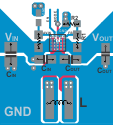SLVSDK8 December 2016 TPS63027
PRODUCTION DATA.
- 1 Features
- 2 Applications
- 3 Description
- 4 Typical Application
- 5 Revision History
- 6 Device Comparison Table
- 7 Pin Configuration and Functions
- 8 Specifications
- 9 Detailed Description
- 10Application and Implementation
- 11Power Supply Recommendations
- 12Layout
- 13Device and Documentation Support
- 14Mechanical, Packaging, and Orderable Information
Package Options
Mechanical Data (Package|Pins)
- YFF|25
Thermal pad, mechanical data (Package|Pins)
Orderable Information
12 Layout
12.1 Layout Guidelines
The PCB layout is an important step to maintain the high performance of the TPS63027 devices.
- Place input and output capacitors as close as possible to the IC. Traces need to be kept short. Routing wide and direct traces to the input and output capacitor results in low trace resistance and low parasitic inductance.
- Use a common-power GND
- Use separate traces for the supply voltage of the power stage; and, the supply voltage of the analog stage.
- The sense trace connected to FB is signal trace. Keep these traces away from L1 and L2 nodes.
12.2 Layout Example
 Figure 21. TPS63027 Layout
Figure 21. TPS63027 Layout